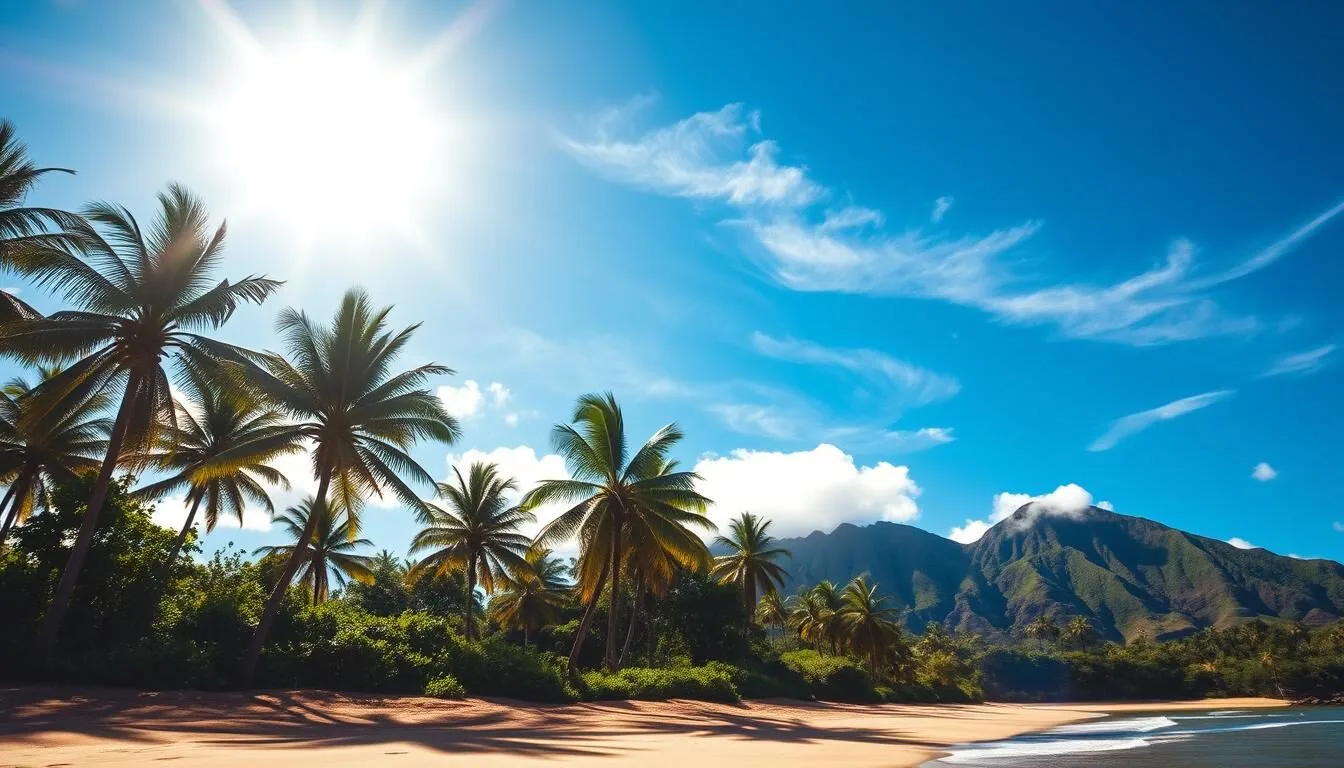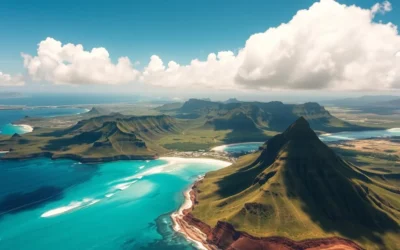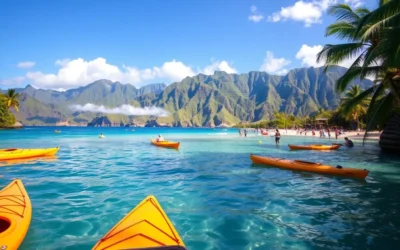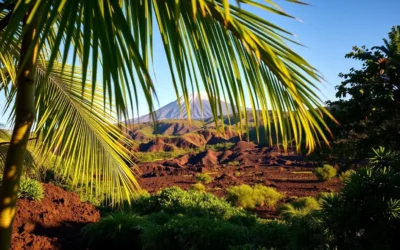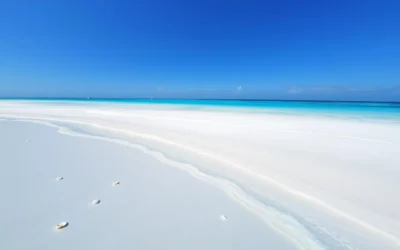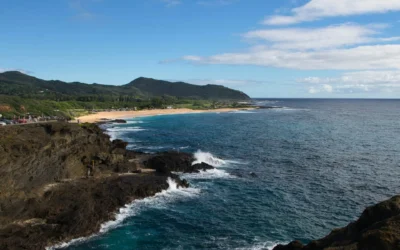✓ Accommodations ✓ Flights ✓ Rental Cars ✓ Tours & Activities
Imagine yourself surrounded by lush greenery, pristine beaches, and a tranquil atmosphere. You’re about to discover the ideal times to visit Kauai, Hawaii’s breathtaking Garden Isle.
The island’s unique microclimate creates diverse weather patterns across the island, making it essential to plan your trip according to your preferences for sunshine, rainfall, and temperature.
Understanding Kauai’s weather variations throughout the year will help you make the most out of your vacation, whether you’re looking for beach days, hiking adventures, or simply a relaxing getaway.
Understanding Kauai’s Unique Climate
Kauai’s climate is a defining feature of the island, shaping its landscapes and ecosystems in profound ways. The island’s diverse geography, with its mountains and valleys, creates a variety of microclimates that support a wide range of flora and fauna.
The Garden Isle’s Microclimate Zones
Kauai is known as the “Garden Isle” due to its lush, green landscapes, which are sustained by the island’s complex microclimate zones. These zones are influenced by the trade winds, which bring moisture from the ocean, resulting in significant rainfall in certain areas. The varied microclimates support a rich biodiversity, making Kauai a unique destination.
- The island’s microclimates create a variety of ecosystems, from tropical rainforests to drier, more arid regions.
- The trade winds play a crucial role in shaping these microclimates, bringing much-needed moisture to the island.
Why Kauai Is Hawaii’s Wettest Island
Kauai receives more rainfall than any other Hawaiian island, earning its nickname as the “Garden Isle.” Mount Waialeale, one of the wettest spots on Earth, receives an average of 450 inches of rain annually, creating spectacular waterfalls and lush vegetation. The regular rainfall patterns contribute to Kauai’s incredible biodiversity and create the perfect conditions for tropical rainforests to thrive.
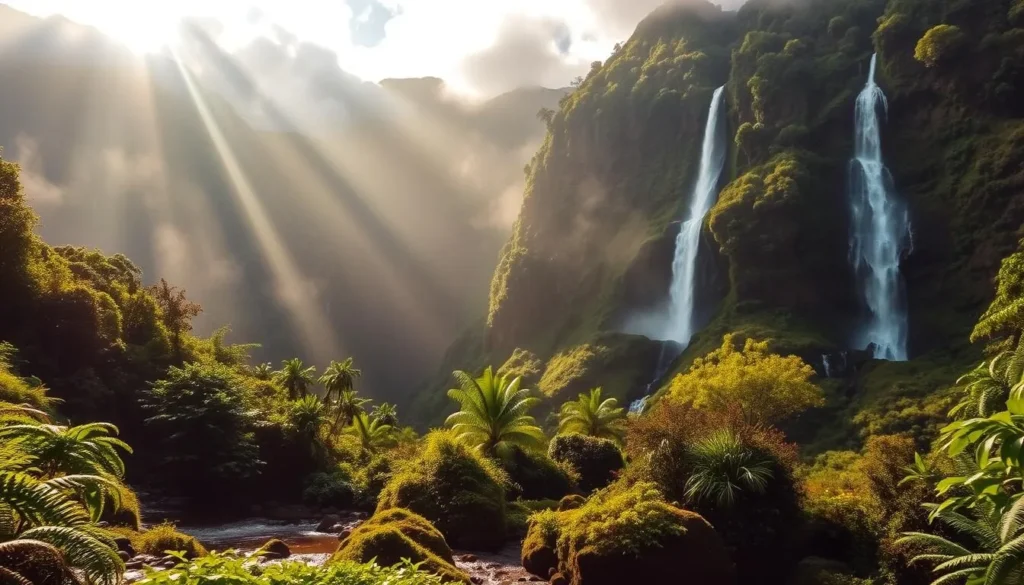
The rainfall on Kauai is not just a weather phenomenon; it’s a defining characteristic that shapes the island’s landscapes and ecosystems. Understanding the rainfall patterns will help you appreciate why occasional showers are a small price to pay for experiencing Kauai’s unparalleled natural beauty.
Kauai’s Two Main Seasons
Understanding Kauai’s two main seasons is crucial for planning a trip that meets your weather preferences. The island’s climate is generally divided into a summer season and a winter season, each with its unique characteristics.
Summer Season: May to October
The summer season on Kauai, spanning from May to October, is characterized by warm and relatively dry conditions. During this time, the average humidity in the mornings is around 75 percent and decreases to 65 percent in the afternoons. This season is ideal for outdoor activities such as hiking, snorkeling, and visiting the beach.
Summer Advantages: The warm weather and calm ocean conditions make it perfect for water sports and enjoying Kauai’s beautiful landscapes.
| Month | Average High Temperature | Average Rainfall |
|---|---|---|
| May | 78°F | 3.5 inches |
| June | 80°F | 2.5 inches |
| July | 82°F | 2 inches |
| August | 84°F | 2.2 inches |
| September | 84°F | 2.8 inches |
| October | 82°F | 3.2 inches |
Winter Season: November to April
Kauai’s winter season, from November to April, brings more rainfall and slightly lower temperatures. However, this season also has its advantages, including fewer crowds and lower prices, making it a potentially more authentic island experience.
The rain showers during winter are typically brief and localized, allowing you to drive to a different part of the island to find sunshine. The increased rainfall creates more dramatic waterfalls and lusher landscapes, perfect for photography enthusiasts and nature lovers.
- Winter temperatures range from 65°F to 78°F, making it still quite comfortable.
- The north shore experiences bigger waves, ideal for experienced surfers.
- The south shore remains relatively calm, suitable for families and beginners.
Kauai, Hawaii: Best Months for a Weather-Savvy Trip
The best time to visit Kauai isn’t just about avoiding rain; it’s about experiencing the island at its best. Understanding the nuances of Kauai’s climate can significantly enhance your trip, making the difference between a good vacation and a great one.
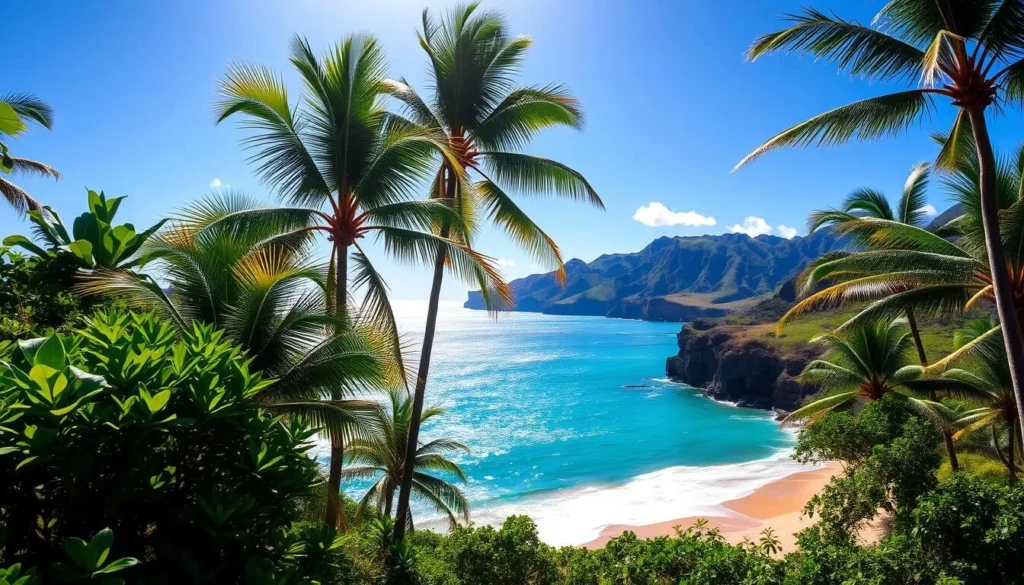
April to June: Ideal Weather and Fewer Crowds
Visiting Kauai from April to June offers a unique blend of favorable weather conditions and smaller crowds. During this period, the island transitions from its wet winter season to the dry summer months, providing pleasant temperatures and fewer rainy days. You can enjoy outdoor activities like hiking, beach trips, and exploring the island without the peak season crowds.
May is particularly noteworthy as it falls within this sweet spot, offering a serene atmosphere as the island isn’t yet buzzing with summer visitors. The first week of June is also an excellent time to visit, just before schools let out for summer break, ensuring a more relaxed experience at popular attractions.
September to November: The Sweet Spot
Another ideal window for visiting Kauai is from September to November. After the summer rush and Labor Day weekend, the crowds dissipate, leaving the beaches and attractions more accessible. The weather remains warm, and the rainfall is relatively low, making these months perfect for enjoying the island’s natural beauty.
September retains much of the summer warmth while seeing a significant drop in tourism, giving you more space to enjoy popular spots. October is an excellent value period, with lower accommodation rates before the holiday season begins, and plenty of sunshine for beach activities. Early November presents a final opportunity to enjoy favorable conditions before the winter rains increase, making it an excellent time for hiking, beach activities, and island exploration.
By choosing to visit Kauai during these periods, you can enjoy a more relaxed, crowd-free experience, making the most of your trip to this beautiful Hawaiian island.
Month-by-Month Weather Guide to Kauai
To make the most of your Kauai adventure, it’s essential to grasp the island’s month-by-month weather guide. Understanding the fluctuations in weather will help you plan your activities and make the most of your trip.
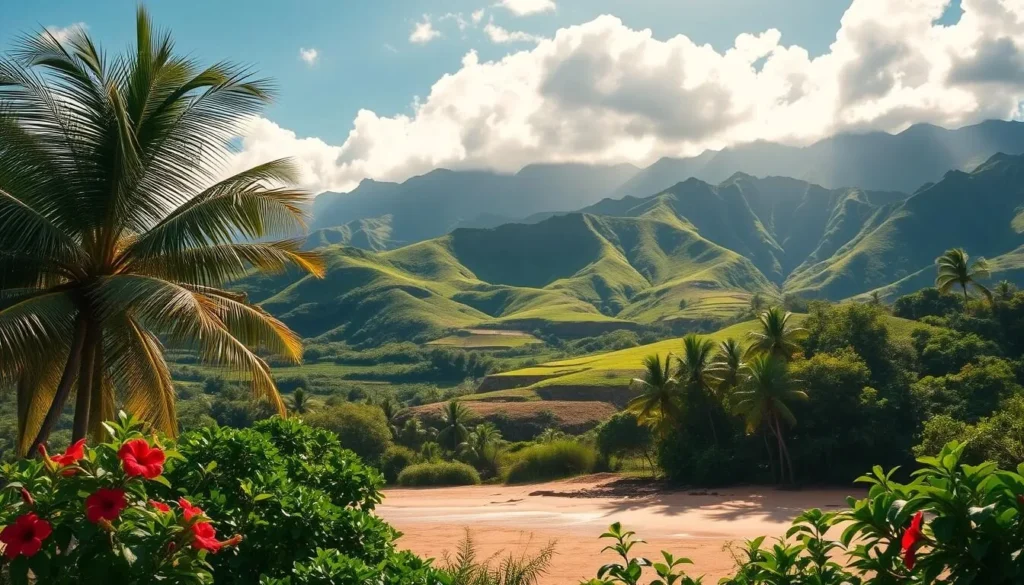
January to March: Winter Patterns
From January to March, Kauai experiences its winter patterns, characterized by cooler temperatures and increased rainfall. January is one of the wettest months, with the north shore receiving the most significant amount of rain. However, the rain showers are often brief, and the sunshine between them can still be plentiful.
During this time, the ocean temperatures are cooler, but still pleasant for swimming and other water activities. If you’re planning to visit during these months, be sure to pack accordingly and take advantage of the lush landscapes that the rain brings.
April to June: Spring Transition
As we transition into April, May, and June, Kauai’s climate begins to shift towards spring. The weather becomes milder, and the crowds are smaller compared to the peak summer months. April and May are particularly pleasant, with warm weather that’s not too hot, making it ideal for outdoor activities like hiking and exploring the island.
October may be considered a sweet spot for a Hawaii adventure, but April to June offers a similar charm with pleasant weather and fewer crowds. You’ll find that the ocean feels just right for swimming, and the overall conditions are perfect for enjoying the island’s natural beauty.
July to September: Summer Peak
Summer is in full swing from July to September, bringing warm weather and long days. This is the peak tourist season, with schools on summer break and families on vacation. While it’s a great time to enjoy the beaches and outdoor activities, it’s also the busiest time of the year.
If you’re visiting during these months, be prepared for larger crowds and higher prices for accommodations. However, the weather is generally sunny and dry, making it perfect for beach activities and water sports.
October to December: Fall to Winter Shift
As the summer months come to a close, Kauai transitions into the fall season, and eventually, winter. October begins with summer-like conditions before gradually transitioning to wetter patterns as winter approaches. November marks the beginning of the rainy season, particularly in the second half of the month.
December brings the highest average rainfall of the year, especially on the north shore. While this might deter some, it also creates the most vibrant waterfalls and lushest landscapes, making it a great time for nature lovers and those looking for a more serene experience.
North Shore vs. South Shore Weather
When planning your trip to Kauai, understanding the weather patterns across different parts of the island is crucial. The island’s diverse climate means that the weather can vary significantly between the North Shore and South Shore, impacting your vacation experience.
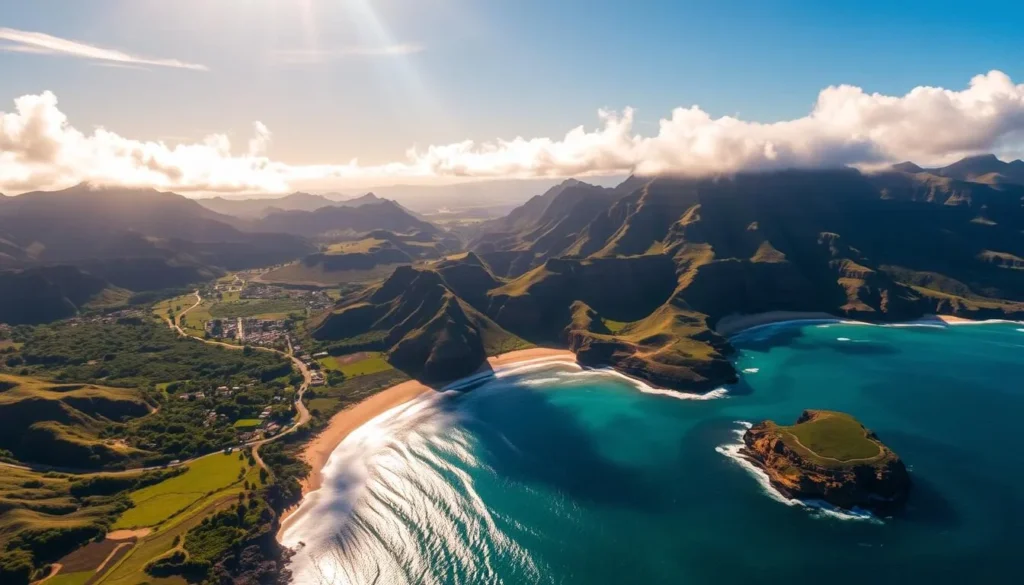
The North Shore, known for its lush landscapes and dramatic coastlines, tends to be wetter than the South Shore. This is due to its exposure to prevailing trade winds that bring moisture from the ocean.
Princeville and Hanalei Climate Patterns
Princeville and Hanalei, located on the North Shore, are characterized by their high rainfall. These areas are lush and green, making them ideal for nature lovers. However, the frequent rain showers can impact outdoor activities.
Poipu and Waimea’s Drier Conditions
In contrast, the South Shore, particularly areas like Poipu and Waimea, enjoy drier conditions. Poipu offers a perfect blend of dry weather and excellent tourist infrastructure, with numerous resorts and activities. Waimea, near the spectacular Waimea Canyon, is actually the driest part of the island, though accommodation options are more limited.
- The south shore receives significantly less rainfall than the north shore, making it an ideal base for visitors prioritizing beach time and sunshine.
- Staying on the south shore provides more predictable weather for planning activities, though day trips to the lusher north shore are recommended.
By choosing where to stay based on the weather patterns, you can make the most of your time on the island, enjoying both the sunny south and the lush north.
Rainfall Patterns Across the Island
Rainfall on Kauai varies significantly across different parts of the island. This variability is due to the island’s diverse landscapes and microclimates. Understanding these patterns can help you plan your activities and make the most of your visit.
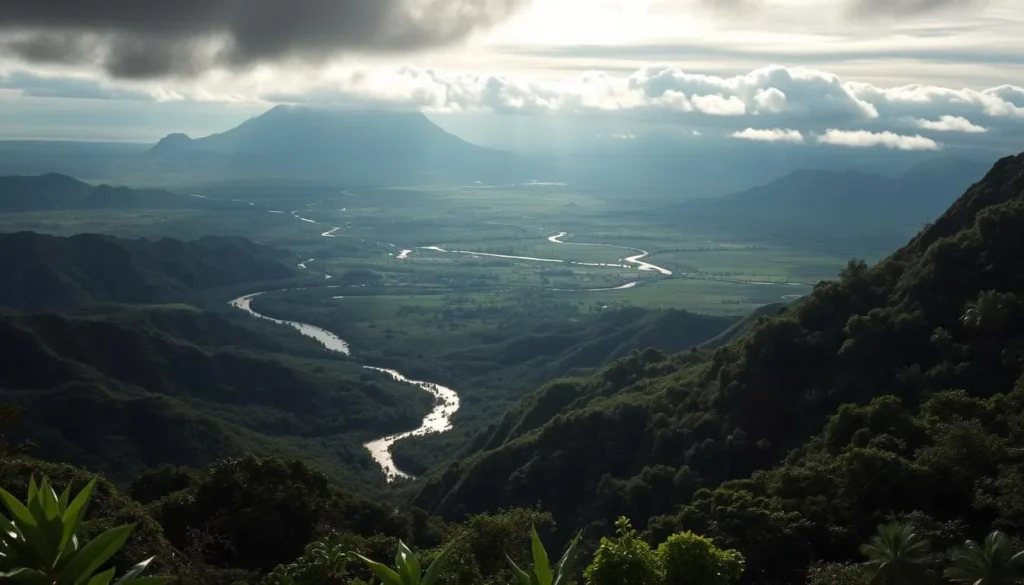
Mount Waialeale: One of Earth’s Wettest Spots
Mount Waialeale, located in the center of Kauai, is known as one of the wettest places on Earth. The mountain receives an average of around 450 inches of rainfall annually, creating a lush and verdant environment. This extreme rainfall contributes to the island’s unique ecosystems and landscapes.
The high rainfall in this area is due to its geography. The mountain’s height forces warm, moist air to rise and cool, resulting in frequent and intense precipitation. While this area is not typically visited by tourists, it plays a crucial role in shaping Kauai’s environment.
How to Plan Around Rain Showers
While rain showers can occur at any time, there are strategies to minimize their impact on your activities. Morning activities are generally safer bets, as rainfall tends to increase in the afternoon, particularly on the north and east sides of the island. You can also take advantage of Kauai’s compact size by driving to a different part of the island to find sunshine when rain appears in your area.
Having flexible plans and backup options is key to enjoying Kauai in any season. Many visitors find that brief rain showers enhance their experience, creating dramatic rainbows, cooler temperatures for hiking, and more impressive waterfalls without significantly disrupting their day. By being prepared and adaptable, you can make the most of your time on the island.
Hurricane Season Considerations
Understanding hurricane season is crucial for a well-prepared and enjoyable trip to Kauai. Hurricane season can impact your travel plans, and being aware of the risks can help you make informed decisions.
June to November Risk Assessment
Kauai is susceptible to hurricanes between June and November. During this time, the risk of heavy rain and thunderstorms increases, which can lead to flash flooding. For instance, in 2018, Kauai experienced severe flash floods, with nearly 50 inches of rain in 24 hours on the north shore, setting a new national record.
To stay safe, it’s essential to stay informed about weather conditions. You can sign up for weather alerts through your phone and follow local Kauai news sources before and during your trip.
Preparing for Potential Weather Disruptions
To minimize disruptions, consider the following strategies:
- Purchase travel insurance that covers weather-related cancellations and disruptions.
- Book accommodations with flexible cancellation policies during hurricane season.
- Choose properties with backup generators in case of power outages.
- Have a basic emergency plan, including knowing your evacuation route and keeping an emergency kit.
| Preparation Tips | Benefits |
|---|---|
| Travel Insurance | Financial protection against weather-related disruptions |
| Flexible Accommodations | Ability to cancel or change plans without penalty |
| Backup Generators | Continuous power supply during outages |
Best Times for Popular Activities
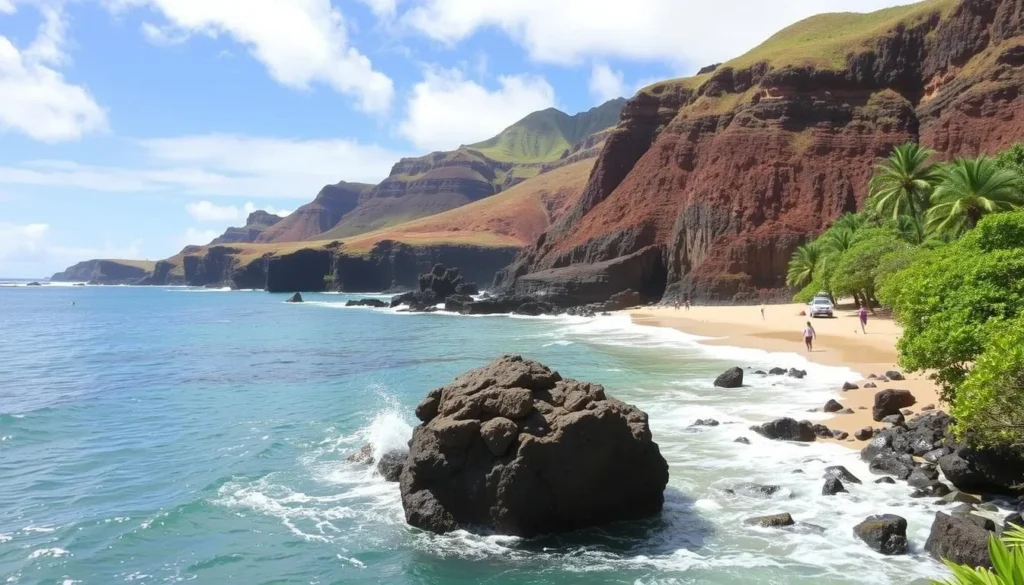
Kauai, Hawaii, is a paradise for outdoor enthusiasts, offering a wide range of activities that cater to different interests and preferences. The island’s diverse climate and geography make it an ideal destination for nature lovers and adventure seekers alike.
Hiking Season: When to Hit the Trails
The best time for hiking in Kauai is during the drier months, from May to October, when the trails are less muddy and more accessible. The Kalalau Trail, for example, is more manageable during this period, offering breathtaking views of the Na Pali coastline.
Beach and Swimming Conditions by Month
The ocean begins to calm during the summer months, particularly on the north shore, making more beaches safely swimmable. As summer approaches, the water conditions improve, making it ideal for swimming and other water activities.
The south shore beaches, such as Poipu and Lawai, generally have better swimming conditions year-round due to their drier climate.
Surfing Windows: North Shore vs. South Shore
The north shore of Kauai is known for its big waves during the winter months, making it a popular destination for surfers. The south shore, on the other hand, has more consistent waves during the summer months, ideal for surfers of all levels.
Snorkeling and Water Visibility Factors
The best time for snorkeling in Kauai is during the summer months (May through October), when water visibility is at its peak and ocean conditions are calmest. The drier south shore beaches like Poipu and Lawai are generally better for year-round snorkeling than north shore locations.
After heavy rains, it’s best to wait 1-2 days before planning snorkeling activities, as rivers can discharge sediment into the ocean, temporarily reducing visibility.
Avoiding the Crowds: Low Season Benefits
For a more authentic Kauai experience, consider avoiding the peak tourist season and exploring during the shoulder months. This approach allows you to enjoy the island’s natural beauty without the crowds, making your visit feel more relaxed and enjoyable.
Least Crowded Months on Kauai
The periods from late April to early June and September to early November are considered the least crowded on Kauai. During these shoulder seasons, you’re likely to find fewer tourists at popular spots, making it easier to appreciate the island’s charm.
To give you a better idea, here’s a comparison of visitor numbers during different periods:
| Period | Visitor Numbers | Weather Conditions |
|---|---|---|
| Peak Season (Summer) | High | Warm, Sunny |
| Shoulder Season (Apr-Jun, Sep-Nov) | Moderate | Mild, Pleasant |
| Off-Season (Dec-Mar) | Low | Cooler, Rainier |
Balancing Weather and Visitor Numbers
While avoiding crowds is a priority, it’s also important to consider the weather. Kauai’s shoulder seasons offer a great balance between favorable weather and manageable visitor numbers. If you can’t avoid peak periods, consider staying in less touristy areas or visiting popular spots early in the morning to beat the crowds.
Tips for a Crowd-Free Experience:
- Plan your visit during the shoulder seasons for optimal weather and fewer crowds.
- Explore less touristy areas like Kapaa or Waimea.
- Visit popular attractions early in the morning.
- Prefer weekdays over weekends when locals also visit popular spots.
Budget Considerations by Season
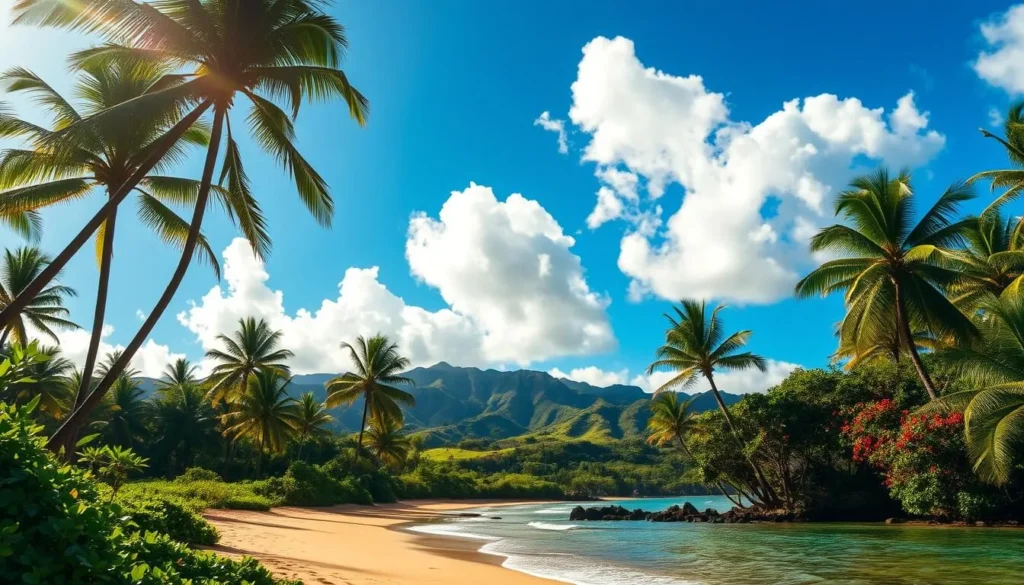
If you’re looking to save money on your Kauai vacation, understanding the seasonal budget considerations is crucial. The cost of visiting Kauai can vary significantly depending on the time of year you choose to travel.
Flight and Accommodation Price Trends
Flight and accommodation prices are key factors in determining the overall cost of your trip to Kauai. Generally, prices for hotels and vacation rentals tend to be lower during the fall season, particularly in September and October. This period offers a great balance between comfortable weather and lower accommodation rates. Car rental prices also tend to decrease during these months, making it an ideal time for travelers on a budget.
Value Seasons for the Budget-Conscious Traveler
The best value seasons for visiting Kauai are the fall months (September to early November) and the spring shoulder season (April to early June). During these periods, you can enjoy lower prices, fewer crowds, and favorable weather conditions. September is particularly excellent, offering summer-like weather at significantly reduced rates for accommodations, car rentals, and activities after the Labor Day holiday. Package deals that combine flights, accommodations, and car rentals are also more abundant during these value seasons, providing substantial savings. For the most budget-friendly experience, consider visiting during the first two weeks of November or the first two weeks of May.
By planning your trip during these value seasons and being mindful of your accommodation choices, you can have a cost-effective and enjoyable vacation in Kauai.
Special Weather Phenomena on Kauai
As you plan your trip to Kauai, understanding the special weather phenomena can enhance your experience. Kauai’s unique geography and location in the Pacific create some remarkable weather events that are worth exploring.
Rainbow Season: When to Catch the Most Colorful Skies
Kauai is renowned for its vibrant rainbows, often referred to as the “Garden Isle.” The island’s lush landscapes and frequent rain showers create ideal conditions for witnessing these colorful displays. The best time to see rainbows is during the late morning and early afternoon when the sun is high and the air is filled with water droplets. You’ll have a good chance of spotting rainbows throughout the year, but the frequency of rain showers varies by season.
Trade Winds and Their Impact on Your Visit
Kauai’s trade winds play a crucial role in shaping the island’s climate and your overall experience. These consistent northeast winds provide relief from the heat during the summer months, making the temperatures more bearable. The trade winds are strongest from May to September, creating pleasant conditions for outdoor activities. However, they can occasionally affect certain activities like kayaking or stand-up paddleboarding. Understanding the trade wind patterns can help you plan your activities more effectively, such as scheduling morning water activities before the winds pick up.
Packing Tips for Different Seasons
Packing for Kauai requires a thoughtful approach, taking into account the island’s unique weather conditions during different times of the year. Understanding the seasonal variations will help you prepare the right clothing and accessories for a comfortable trip.
Summer Essentials for Kauai
During the summer months, Kauai’s weather is warm and sunny, making it ideal for beach activities and outdoor adventures. You’ll need to pack lightweight, breathable clothing, including swimwear, shorts, and t-shirts. Don’t forget to include sun protection such as sunscreen, a hat, and sunglasses to enjoy the island’s beautiful beaches and water activities.
| Item | Description |
|---|---|
| Swimwear | Pack a few swimsuits for beach and water activities |
| Sun Protection | Includes sunscreen, hat, and sunglasses |
| Light Clothing | Shorts, t-shirts, and other lightweight clothing |
Winter Weather Gear for the Garden Isle
In the winter, Kauai experiences a slight drop in temperature, especially in the evenings, making a light jacket or sweater a useful addition to your packing list. You’ll also need to consider the potential for rain showers, particularly on the north and east shores, making a compact umbrella or rain jacket essential. For those planning to hike, waterproof hiking shoes are strongly recommended due to muddy and slippery trails.
- A light jacket or sweater for cooler evenings
- A compact umbrella or rain jacket for unexpected rain showers
- Waterproof hiking shoes for hiking and outdoor activities
Conclusion
From the lush north shore to the sunny south shore, Kauai’s varied landscapes and climates ensure that there’s always something beautiful to experience. You now have a comprehensive understanding of the best months to visit Kauai based on your personal preferences for weather, crowds, and activities.
April to June and September to November emerge as the sweet spots for most visitors, offering the ideal balance of pleasant weather, fewer crowds, and reasonable prices compared to peak seasons. These periods are perfect for hiking the Napali Coast, surfing on the north shore, or simply relaxing on beautiful beaches.
Remember that Kauai’s weather varies dramatically by location. The sunny south shore (Poipu, Waimea) offers more reliable dry conditions, while the lush north shore (Hanalei, Princeville) receives more rainfall that creates its famous dramatic landscapes. No matter when you choose to visit, Kauai offers year-round opportunities for unforgettable experiences.
The Garden Isle’s unique charm lies in its diversity – from its microclimate zones to its range of activities – making it a perfect destination regardless of when you visit. At the end of the day, the best time to visit Kauai is whenever you can make the trip, as this spectacular island offers natural beauty and memorable experiences throughout the year.
Whether you’re planning a honeymoon, family vacation, adventure trip, or relaxing getaway, Kauai’s breathtaking landscapes and warm aloha spirit await you in every season. Bring your sense of adventure and appreciation for one of the most beautiful places on Earth, and you’ll be sure to have an unforgettable experience.
The above is subject to change.
Check back often to TRAVEL.COM for the latest travel tips and deals.
